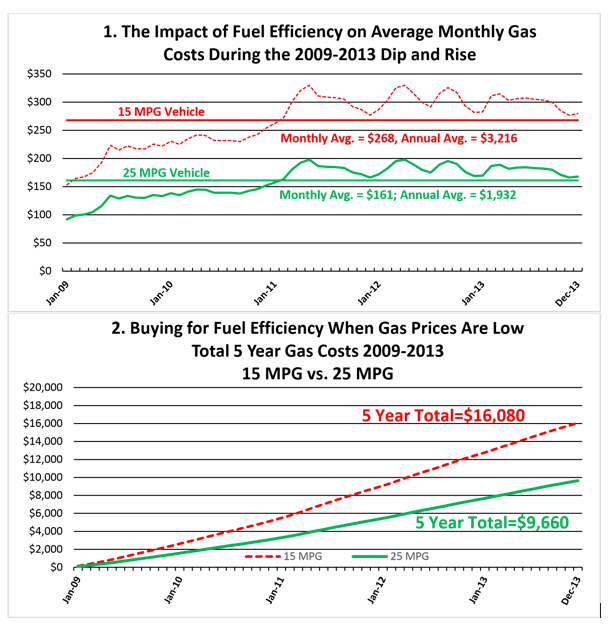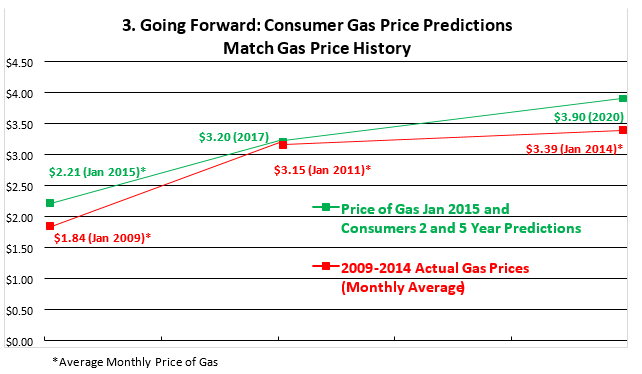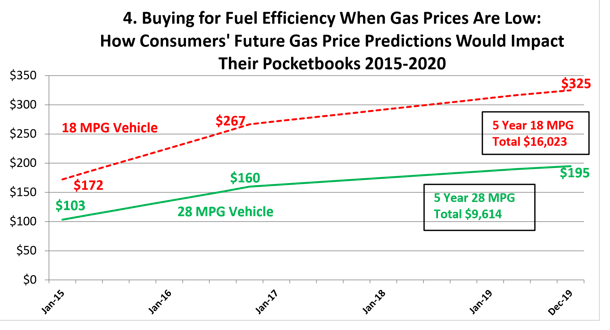Washington, DC — The latest national survey on consumer attitudes toward energy commissioned by the Consumer Federation of America (CFA) reveals that consumers expect the national gasoline price average to rise by almost 50 percent in the next two years – from about $2.14 to $3.20 – and by over 80 percent in the next five years – to $3.90. In spite of the current low gas prices, the survey also reveals that consumers have incorporated this expectation into their next vehicle purchase. More than four-fifths (86%) say that gas mileage will be “important” in their next purchase, while over half (57%) say it will be “very important” in determining what vehicle to purchase.
“There’s a good reason why today’s car buyers still believe fuel efficiency is important—they understand that gas prices always go back up,” said Jack Gillis, Director of Public Affairs and author of The Car Book.
A new CFA analysis of the last dip and rise in gas prices (2009-2014) confirms why consumers still want higher mileage vehicles in the face of low gas prices. In January 2009, the monthly average price of gas was $1.84. Five years later – the typical term of a new car loan– the monthly average gas price rose to $3.36. In January 2009, consumers who were lulled into purchasing lower mileage vehicles due to low gas prices ended up spending thousands more than the fuel-efficient buyers during the time they owned the vehicle. For example, buying a 15 mpg vehicle in January 2009 would have resulted in a monthly gas expenditure of $153 for that January. Five years later, that monthly average expenditure would skyrocket to $268. During the first five years of ownership; these buyers would spend over $6,400 more on gas than if they had purchased a 25 mpg vehicle. And, there were plenty of vehicle choices within the same vehicle category getting between 15 and 25 mpg in 2009, so buying a higher mileage vehicle would not have required moving to another class of vehicle.
“Buying an inefficient vehicle during periods of low gas prices condemns the consumer to wider swings in monthly costs, much higher monthly peaks, and a whopping overall increase in lifetime gas costs,” said Dr. Mark Cooper, CFA’s Director of Research.
The following two graphs show the dramatic pocketbook differences between vehicle choices during a period of low gas prices. Not only would the average monthly gas cost for a 15 mpg vehicle for five years jump to $268 compared to the $153 per month from when the vehicle was purchased, but because gas prices were so volatile post- 2009, the monthly average cost to fill up would fluctuate widely from $153 per month to $330 per month.

Consumers Understand Gas Price Volatility and Still Want More Fuel Efficiency When Prices Are Low
CFA’s new national survey asked consumers to identify the gas mileage they want in their next vehicle purchase compared to the gas mileage of their current vehicle. On average, respondents reported that they expected the gas mileage of their next vehicle to be 30 mpg compared to the 25 mpg rating of their current vehicle. “Consumers are smart and have long memories, so it’s no surprise that they still want more fuel efficiency even though today’s gas prices may be low,” said Gillis.
Looking forward, consumers believe that two years from today gas prices will be$3.20; and $3.90, five years from now. (See Graph 3 below.) “Not only do these consumer expectations match the last major dip and rise in gas prices (2009-2014), but they show that consumers understand when gas goes down, it inevitably goes back up,” said Cooper.

Given the general increase in fleet fuel efficiency from 2008 to today, CFA compared the five-year gas expenditures of buying an 18 mpg vehicle versus buying a 28 mpg vehicle now, during this period of low gas prices. Using the average prices projected by consumers in the CFA survey, a buyer making the 18 mpg purchase is likely to spend nearly $5,000 more on gas during the next five years than the buyer of a 28 mpg vehicle. With an 18 mpg vehicle, those seemingly low $178 average monthly gas costs could balloon to $267 in just two years and nearly double in five years to $325 per month. (See Graph 4 below.) “What is particularly significant about this choice is that today is it very easy to make a much more fuel-efficient choice within nearly every vehicle category,” said Gillis.

Carmaker’s Support for CAFE’s 54.5 MPG by 2025 was Well-Founded
“Clearly consumers want and are buying more fuel efficient vehicles. Those manufacturers who stay on the road to 54.5 mpg by 2025 will be the best-positioned to take advantage of this consumer demand,” said Gillis. “Manufacturers who fall short of the standard, or push back during the mid-course review, do so at their own peril. They will clearly suffer in the market.” In 2017, the federal government will review the progress of the 54.5 mpg fuel economy standard and could potentially lower, raise or keep the standard the same, based on feedback from key stakeholders—like automakers.
“Policymakers got it right in 2012, when they provided the path for the historic agreement by the car companies, labor unions, environmentalists, safety and consumer advocates to get us to 54.5 mpg by 2025,” said Cooper.
For CFA’s in-depth report, see: ‘Staying on the Road to 54.5 MPG By 2025.’
The Consumer Federation of America is a nonprofit association of more than 250 consumer groups that was established in 1968 to advance the consumer interest through research, advocacy, and education.

